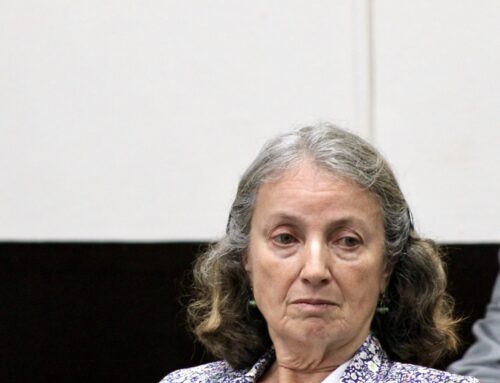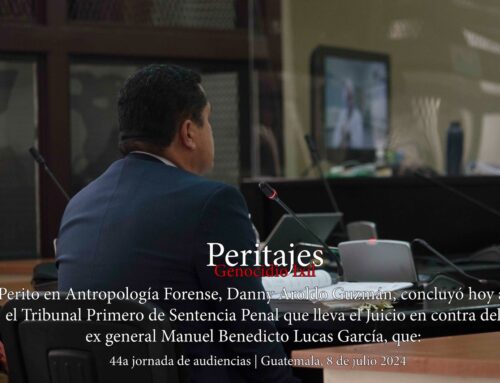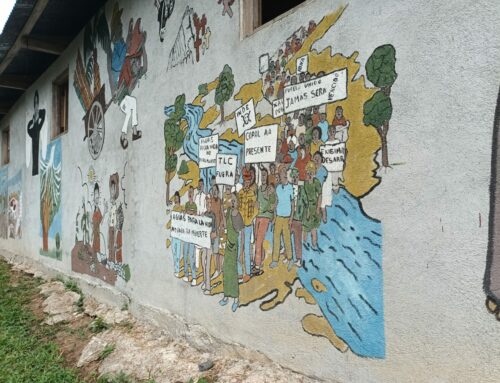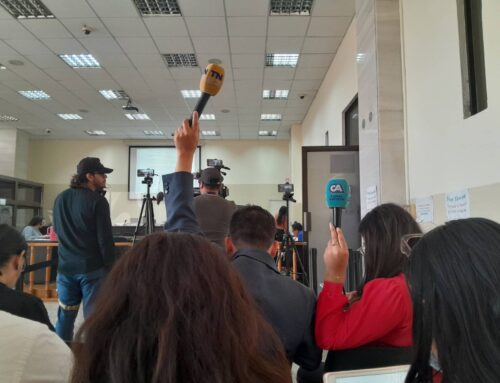The deceased, all wounded by firearm, according to Dr. Jorge Destarac, regional head of the National Forensic Science Institute, were eight in total: Rafael Batz (Pasajoc), Santos Nicolás Menchú (Pasajoc), Jesús Baltazar Caxaj Puac (Chipuac), Francisco Ordoñez (Chipuac), José Eusebio Puac Ordoñez (Chipuac), Arturo Félix Sapón Yax (Panquix), Domingo Caniz (Chipuac), and one more from Santa Catarina Ixtahuacán whose family members did not permit INACIF to open the body because in their cosmovision this would not allow him to arrive complete to “Ajaw” (Heaven).
– “Totonicapán, todos los ausentes” by Oswaldo J. Hernández in Plaza Pública
 |
| Statue of K’iche leader Atanasio Tzul in Totonicapán, with black mourning cape. (Via Guatemala Indymedia Center) |
The death toll of last week’s massacre of Maya K’iche protesters in Totonicapán continues to increase, with reports of up to 8 or 9 killed; at least 6 of the 34 people injured in the attack remain hospitalized. Initial evidence, as well as eye-witness testimony, confirms the denunciation of the 48 communities of Totonicapán that military and police forces fired on the unarmed protesters. In addition to now iconic photos showing a bloodied protester surrounded by security forces and Guatemalan military personnel with weapons aimed at crowd level, the Guatemalan Human Rights Ombudsman’s office reported that shell casings from the Israeli Galil machineguns used by the Guatemalan army were found at the scene of the massacre. The government continues to claim that a private security guard initiated the violence and that soldiers sent to the scene of the protest fired in the air in self defense.
(Trauma warning: video depicting severe injuries and testimony of violence)
“However, in addition to the habits of counterinsurgency, what sustains the repressive project of this government is neoliberal dogma. Anti-communist paranoia undoutably persists, but today the energy of state terrorism is maintained by the need for savage accumulation created by neoliberalism. The 48 communities of Totonicapán were protesting against the infamously abusive electricity fees which have been imposed by a private company, now nown as Energuate. They were also protesting against an education reform which makes teaching careers inaccessible for the poor, and finally against constitutional reforms which have been made to deepen the implantation of neoliberalism. The objective of this unrestrained violence is not just to put a stop to discontent in Totonicapán, but to spread the terror that is needed to disarticulate growing popular protest against open-pit mining, hydroelectric dams, cement factories, highways, crops like african palm. The manager of a business lobby has said that what is happening is that there are groups interested in boycotting hardworking Guatemalans. It sounds like the old saw of the lazy poor and the industrious rich. What is happening is that all of these business projects require the displacement of campesino and indigenous communities, poisoning them with pollution and destroying their community fabric and way of living in order to achieve the highest profits.”
– “Habits of counterinsurgency and neoliberal dogma” by Carlos Figueroa Ibarra in Rebelión
The violent repression of indigenous protestors may also entrench reactionary elements in Guatemala. In an essay titled “Estamos en guerra, mi amor,” Julio Roberto Prado explores the deep fractures of Guatemalan society. While suggesting that questions of tactics (the use of roadblocks, unpopular with a middle class that imagines affinity with the economic oligarchy) have exacerbated political divisions, Prado is more horrified at the urban middle class and its response to the massacre, a “petri dish of the deepest and most wounding prejudices which circulate in our imagination. About the incident in Totonicapan, I have been able to find all kinds of phrases which justify, legitimize, and demand the application of violent measures against the protesters. Which disregard life, in sum. …That is to say that our educated fellow citizens contemplate extermination. And this opinion finds enormous backing from the most conservative sectors of the country. It is enough to read the statements of
[the business association] CACIF. They have stated that the actions of the government are justified and that they would be speaking with the Attorney General about the subject.” CACIF has called for protest leaders to be prosecuted for violating the right to freedom of movement in their roadblock.
In the decade and half since the signing of the Peace Accords, Guatemala’s social movements have found important points of unity around long-standing issues such as the struggle of campesino communities for land, and against the racism and exploitation to which indigenous people have continually been subjected. Urban and rural activists are united in campaigns for memory and justice, and new fronts have opened for the self-determination of indigenous communities through resistance to mining and other mega-development projects. While the repression in Totonicapán can hardly be claimed to be Guatemala’s “first peace-time massacre”—9 campesinos and 3 police died in the violent eviction at Nueva Linda in 2004, and 3 were killed and dozens wounded in evictions in the Polochíc valley last year—the militarized character of the Patriot Party government and the specter of soldiers firing on civilian protesters is likely to sharpen already deep conflict between indigenous and social movements and the government and elite economic sectors.
Blog post written by Phil Neff, member of NISGUA’s grassroots network, former staff member and author of the Cascadia Solidaria blog. Original post here.






Leave A Comment